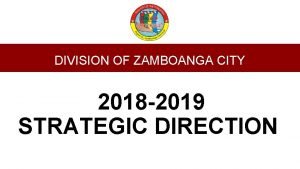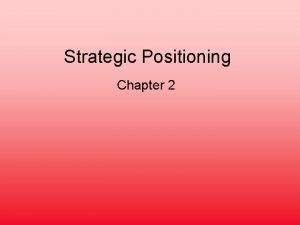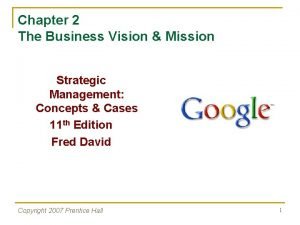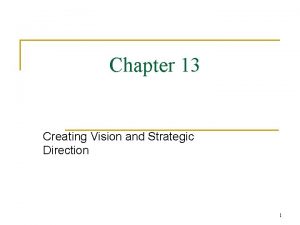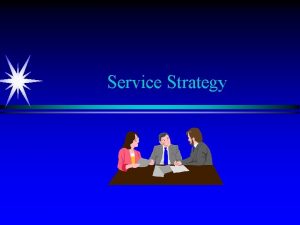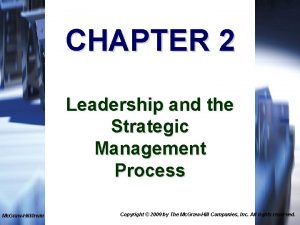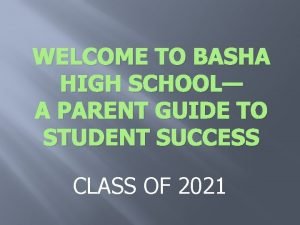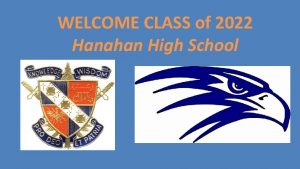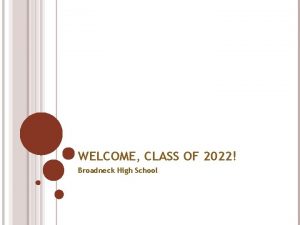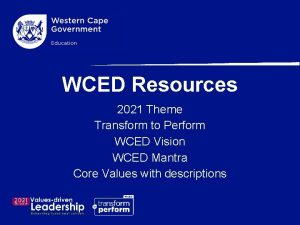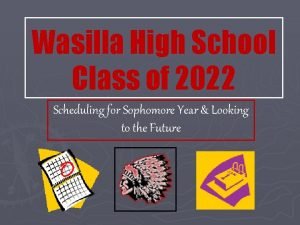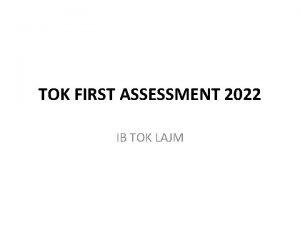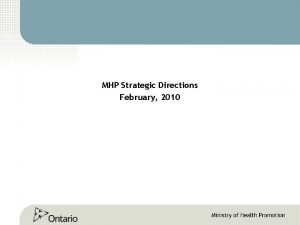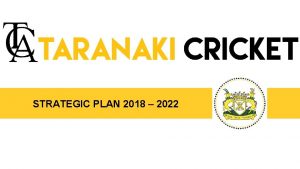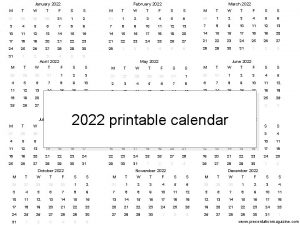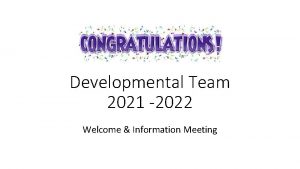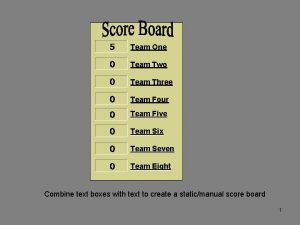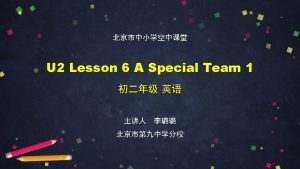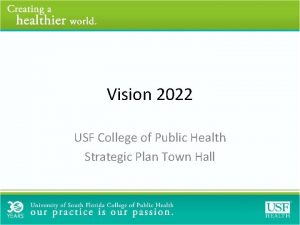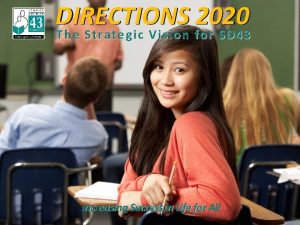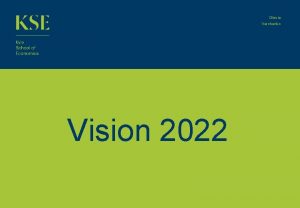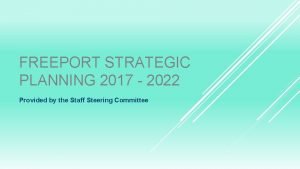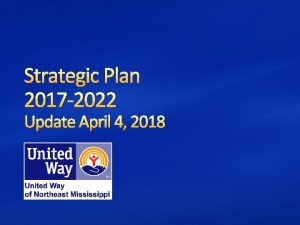STRATEGIC DIRECTIONS FY 2017 2022 Vision Team Vision




















- Slides: 20

STRATEGIC DIRECTIONS FY 2017 -2022

Vision Team Vision Long-Term Vision We dream of Filipinos who passionately By 2022, Dep. Ed is a modern, love their country and whose values and professional, pro-active, nimble, trusted competencies enable them to realize and nurturing institution delivering their full potential and contribute quality, accessible, relevant and meaningfully to building the nation. liberating K to 12 Education, enabling our learners to be As a learner-centered public institution, nation-loving, resilient and competent the Department of Education lifelong learners continuously improves itself to better serve its stakeholders. Core Values • Maka-Diyos Makatao Makakalikasan Makabansa

Mission To protect and promote the right of every Filipino to quality, equitable, culture-based and complete basic education where: Students learn in a child-friendly, gender-sensitive, safe and motivating environment; Teachers facilitate learning and constantly nurture every learner; Administrators and staff, as stewards of the institution, ensure an enabling and supportive environment for effective learning to happen; and Family, community and other stakeholders are actively engaged and share responsibility for developing lifelong learners.

Development Frameworks and Priorities Global Educ Goals SDG 4 2030 Ensure inclusive and equitable quality education and promote lifelong learning opportunities for all. Societal Goal The Philippines shall be a country where all citizens are free from hunger and Ambisyon poverty, have equal opportunities, enabled by fair and just society that is governed Natin 2040 with order and unity. Sectoral Goal PDP 2017 -2022 Organizational Goal Dep. Ed 10 Point Agenda Organizational Outcome Dep. Ed Strat Direction 2017 -2022 Lifelong Learning Opportunities for All: Reducing Inequalities in Human Development Quality, Accessible, Relevant and Liberating Education By 2022, Dep. Ed is a modern, professional, pro-active, nimble, trusted and nurturing institution delivering quality, accessible, relevant and liberating K to 12 Education, enabling our learners to be nation-loving, resilient and competent lifelong learners 4

Planning and M&E Framework Goal: All Filipinos are able to realize their full potential and contribute meaningfully to building a cohesive nation Outcome: Holistically developed Filipinos with 21 st Century skills ready for higher education, entrepreneurship and work Intermediate Outcomes: Learners are well-rounded, happy and smart Learners are in school and learning centers Education leaders and managers practice participative and inclusive management processes. Learners access programs responsive to their needs and consistent with their interests and aptitudes Learners actively participate in a learnerfriendly environment Enabling Environment People, internal systems, and Investments in Basic Education provides learners processes serve learners better with ideal learning through continuous environment improvement efforts Learners complete education and attain learning standards Key stakeholders actively collaborate to serve learners better

Planning Phases • Vision, Mission • Mandate • Core Values • Basic Education Situation • Strategic Goals • Strategic Objectives • Higher level Outcomes and Targets (Key Performance Indicators) Strategic Plan (6 -year) Medium-Term Plan (6/2 -year) • Three-year Plan and Targets - Major strategies and Targets - Policies, Programs/ Projects/other interventions - Major outputs and milestones - Inputs (resources) • Policies, Programs/ projects • One year outputs and milestones • Activities • Financial requirements • Procurement requirements • Timing of Activities, Obligation, Disbursement and Procurement Operations Plan (1 -year)

Dep. Ed Strategic Directions (2017 -2022) TEAM VISION STRATEGIC GOAL STRATEGIC OBJECTIVES (Strategies) By 2022, we will have nation-loving and competent lifelong learners able to respond to challenges and opportunities through quality, accessible, relevant and liberating K to 12 Program delivered by a modern, professional, pro-active, nimble, trusted and nurturing Dep. Ed Expand Access to Basic Education • Expand coverage of Inclusion Programs • Expand access to Secondary Education • Provide non-classroom facilities in remote and isolated schools • Improve Partnership building and linkages Improve Quality and Relevance Modernize Education Management & Governance • Maintain ideal ratios of basic education inputs • Improve Quality of Teachers • Expand the use of Technology for Learning • Enrich curricula to address cross-cutting issues and foster critical thinking towards Liberating Basic Education • Automate core systems and processes (e-Governance) • Improve Procurement and Finance System • Accelerate Research & Dev’t • Improve Dep. Ed Independence from interference • Improve Human Resource and Development

Dep. Ed Strategic Directions (2017 -2022) TEAM VISION By 2022, Dep. Ed is a modern, professional, pro-active, nimble, trusted and nurturing institution delivering quality, accessible, relevant and liberating K to 12 Education, enabling our learners to be nation-loving, resilient and competent lifelong learners STRATEGIC GOAL Expand Access to Basic Education Improve Quality and Relevance Modernize Education Management & Governance STRATEGIC OBJECTIVES (Strategies) • By 2022, 75% of ES and 95% of HS are capable to offer inclusion programs • By 2022, number of secondary schools is increased by 25%. • By 2022, 50% of identified remote schools are given non-classroom facilities. • By 2022, Dep. Ed partnership systems and processes is transformed into a “one-stop-shop” center. • By 2022, 98% of Schools achieved ideal ratio on Classroom, Seats, Teachers, WATSAN, Textbooks, Tools & equipment. • By 2022, 90% of teachers are trained on both content and pedagogy. • By 2022, 100% schools with electricity are provided with ICT package and teachers are trained on the use of technology. • By 2022, basic education curricula is fully enriched with cross-cutting issues (GAD, GC, Sexuality Ed, Climate Change, Peace and Devt. , appreciation of Culture and History) • By 2022, Information System for Learner, School, HR, Learning Resources, M&E, Assessment and Finance are fully in-placed and automated. • By 2022, Procurement Process is fully automated and modernized • By 2022, 100% of Dep. Ed policies and program are researched based. • By 2022, Dep. Ed M&E system is fully inplaced and automated across all levels. • By 2022, Training and Development system is in-placed and implemented.

Dep. Ed Strategic Directions (2017 -2022) TEAM VISION STRATEGIC GOAL By 2022, Dep. Ed is a modern, professional, pro-active, nimble, trusted and nurturing institution delivering quality, accessible, relevant and liberating K to 12 Education, enabling our learners to be nation-loving, resilient and competent lifelong learners Expand Access to Basic Education Baseline OUTCOME INDICATORS Net Enrolment Rate (2017): Kindergarten: 83. 7% Elementary: 93. 9% Secondary: 75. 9 Cohort Survival Rate (2016): Elementary: 94. 2% Secondary: 84. 6% Completion Rate (2016): Elementary: 92. 7% Secondary: 82. 4% Improve Quality and Relevance Baseline (2015) National Achievement Test (MPS): Elementary : 69. 1% Secondary : 53. 8% Completers A&E Passers NC Passing Rate 70% 56% Modernize Education Management & Governance Baseline (2017) Teacher to Learner Ratio Elem – 1: 31; HS – 1: 26 Classroom to Learner Ratio Elem – 1: 33; HS – 1: 44 Seat to Learner Ratio – 1: 1 All levels Textbook to Learner Ratio – WATSAN to Pupil Ratio – Interquartile Ratio (2016): Elem – 1: 79 HS- 1: 78 (these indicators are considered indicators of governance since these are results of management decisions aided by evidence generated from Information systems).

Dep. Ed Strategic Directions (2017 -2022) STRATEGIC GOAL Expand Access to Basic Education Targets STRATEGIC OBJECTIVES (Strategies) Baseline (2017) Offices By 2022, 75% of ES and 95% of HS are capable to offer inclusion programs This is related to the concept of “onestop-shop” concept of school – that all schools are capable to cater to the educational needs of all kinds of learners. Nee to set the standards first By 2022, number of secondary schools is increased by 25%. Number of Secondary Schools: EFD (Lead), Pure JHS – 1, 779 Planning JS in Elem School– 496 JHS and SHS in Elem School – 353 JHS with SHS – 5, 925 By 2022, 50% of identified remote schools are given non-classroom facilities. By 2022, Dep. Ed partnership systems and processes is transformed into a “one-stopshop” center. To be identified using remoteness index Target is subject for revision by the office of Usec Umali BLD (Lead), BCD, BLR EFD (Lead), Planning

Dep. Ed Strategic Directions (2017 -2022) STRATEGIC GOAL Improve Quality and Relevance Targets STRATEGIC OBJECTIVES (Strategies) Baseline (2017) Offices By 2022, 98% of Schools achieved ideal ratio on Classroom, Seats, Teachers, WATSAN, Textbooks, Tools and equipment. Teacher to Learner Ratio Elem – 1: 31; HS – 1: 26 Classroom to Learner Ratio Elem – 1: 33; HS – 1: 44 Seat to Learner Ratio – 1: 1 All levels Textbook to Learner Ratio – WATSAN to Pupil Ratio – Number of Schools with water supply: Elem – 32, 215; HS – 7, 333 BLR (Lead), EFD, PS By 2022, 90% of teachers are trained on both content and pedagogy. No clear baseline (to be provided by NEAP or BCD NEAP (Lead), BHROD, BCD By 2022, 100% schools with electricity are provided with ICT package and teachers are trained on the use of technology. Number of energized Schools Elem – 35, 77; HS – 8, 034 Number of Schools with Internet: Elem – 12, 313; HS – 2, 979 Number of Functional Computer: Elem - 314, 578; HS - 383, 878 ICTS (Lead), NEAP By 2022, basic education curricula is fully enriched with cross CI to provide update -cutting issues (GAD, GC, Sexuality Ed, Climate Change, Peace and Devt. , appreciation of Culture and History) BCD (Lead) , BLD, DRRMS

Dep. Ed Strategic Directions (2017 -2022) STRATEGIC GOAL Modernize Education Management & Governance Targets STRATEGIC OBJECTIVES (Strategies) Baseline (2017) Offices • By 2022, Information System for Learner, School, HR, Learning Resources, M&E and Finance are fully in-placed and automated. LIS, EBEIS, HRIS – existing ICTS (Lead) but needs enhancement • By 2022, Procurement and Finance Process are fully automated and modernized Roadmap has been developed PMS and FS • By 2022, all Dep. Ed policies and program are Standard process with researched based. policy cover is in-placed; PS (Lead) • By 2022, Dep. Ed M&E system is fully inplaced and automated across all levels. • By 2022, Training and Development system is in-placed and implemented. PS and ICTS PMIS for progress monitoring is in-placed CPD mechanism is fully in NEAP, BHROD -placed

Programs, Projects and Activities Strateg ic Goal Core Strategies (Objectives) Expand coverage of Access Inclusion Programs to Basic Educati on Support Programs, Projects and Activities • • Multigrade Education Program Madrasah Education Program Indigenous Peoples Education (IPEd) Program Special Education Program (SPED) Alternative Learning System and ADM Child Protection Program School-Based Feeding Program Complete all Incomplete schools into MG school Expand access to Secondary Education • Establish/Open more Junior and Senior High School • Expand Coverage of ESC, Voucher Program and Joint Delivery Strategy for TVL Provide non-classroom facilities in remote and isolated schools • Build Dormitories to school that are remote and geographically isolated • Accelerate Pedals and Paddles project Improve Partnership building and linkages • Strengthen Brigada Eskwela • Expand Adopt a School Program Baseline Data

Programs, Projects and Activities Strategic Goal Core Strategies (Objectives) Support Programs, Projects and Activities Improve Quality and Relevanc e Full implementation of K to 12 Program • • • Improve Quality of Teachers • Intensive Retooling teachers particularly those handling SPED, ALS • Improve Pre-Service Curriculum • Improve hiring and promotion policy Expand the use of Technology for Learning • • Computerization Program Learning Tools and Equipment Expand access to Learning Resource Portal Internet Connectivity Enrich curricula to address cross-cutting issues and foster critical thinking towards Liberating Basic Education • • • Drug Prevention Education Gender and Development Climate Change Mitigation and Adaptation Sex Education Peace Education Promotion and appreciation of history, culture, arts and literature School Facilities Teaching Positions and Non-Teaching Positions Tools and Equipment (by strand) Assessment Textbooks and other Instructional Materials Baseline

Programs, Projects and Activities Strategic Goal Moderniz e Education Managem ent and Governan ce Core Strategies (Objectives) Support Programs, Projects and Activities Automate core systems and processes (e. Governance) • Strengthen existing Information Systems • Develop and Implement FMIS and other system that would improve operations, cut-down red tape and ensure full transparency • Connect all operating Units Improve Procurement and Finance Process • Improve Procurement Planning • Improve Planning Process Accelerate Research and Development • Action Research • Accelerate Impact Evaluation Improve Dep. Ed Independence from interference • Evidence-based planning and policy development • Improve Monitoring and Evaluation System Improve Human Resource and Development • Improve leadership and management skills of Dep. Ed Officials • Expand Employee Welfare Program • Capacity Building for Non-Teaching Personnel Baseline

Achieving the Agency Goals 16

General Administration and Support to Operations Project/ Activity 1. General Management and Supervision 2. Administration of Personnel Benefits 3. Baguio Teachers Camp (BTC) Operations Access of every Filipino to an enhanced basic education program enabling them to prepare for further education and the world of work achieved Program Organizational Budget Outcome Structure Program Expenditure Classification (PREXC) Education Policy Development Program 1. Development and Management of bilateral and multilateral education programs 2. Education Information and Communication Services 3. Learner Support Programs 4. Planning and Management Information Systems 5. Creation of New Positions for Administrative Offices 6. Management and Administration of Learning Resources 7. Building Partnerships and linkages program 8 Physical Fitness & School Sports 9. Disaster Preparedness and Response Program 10. Organizational and Professional Development for Nonschool/LCs personnel 11. Legal Service and development of education-related laws and rules 12. Child Protection Program Basic Education Inputs Program 1. Basic Education Curriculum 1. New School Personnel 2. National Literacy Policies and Programs Positions 2. Improvement and 3. Early Language Literacy Acquisition of School and Numeracy (formerly Sites ECARP) 3. Basic Education 4. National Assessment Facilities Systems for Basic 4. Textbooks and other Education Instructional Materials 5. Policy and Research 5. Computerization Program (formerly Support Program for Basic Education 6. Learning Tools and Research) 6. Curriculum programs, Equipment learning management 7. Conservation and models, standards and restoration of Gabaldon strategy development and other heritage 7. Development and school buildings Promotion of Campus Journalism Inclusive Education Program 1. Madrasah Education Program 2. Indigenous Peoples Education (IPEd) Program 3. Special Education Program 4. Multigrade Education 5. Flexible Learning Options - Alternative Learning Systems (ALS) - Alternative Delivery Modes (ADM) - Education in emergencies (Ei. E) Support to Schools and Learners Program 1. Operations of Schools (formerly Education Human Resource Development Program 1. Human Resource School MOOE) Development for non • Elementary [kinder to Grade 6] school based • Junior High School [Grades 7 -10] Personnel and • Senior High School [Grades 11 learning centers 12] 2. Teacher Quality and 2. Government Assistance and Development Program subsidies: • ESC Program for Private JHSs • Voucher Program for Non. Dep. Ed Public SHSs 3. Joint Delivery Voucher for Senior High School 4. School Feeding Program 5. Implementation of the Grant of Cash allowance, Hardship Pay, Equivalent Record Form (ERF), Conversion to Master Teacher (MT) and Reclassification of Positions

PDP Targets for Basic Education (Outcomes) Indicators Baseline 2015 2016 2017 2018 Targets 2019 2020 2021 2022 By 2022, proportion of School Aged population participating in basic education increased (Net Enrolment Ratio) Kinder 74. 65% 77. 56% 80. 46% 83. 37% 86. 28% 89. 19% 92. 09% 95. 00% Elementary 91. 05% 91. 61% 92. 18% 92. 74% 93. 31% 93. 87% 94. 44% 95. 00% Junior High School 68. 15% 69. 19% 70. 23% 71. 27% 72. 32% 73. 36% 74. 40% 75. 44% Senior High School No Baseline Yet By 2022, proportion of Learners who enrolled in Grade 1/Grade 7 completing Levels of Education increased (Completion Rate) Elementary 83. 43 Junior High School 73. 97 Senior High School 84. 37% 85. 31% 86. 25% 87. 18% 88. 12% 89. 06% 90. 00% 76. 49% No Baseline Yet 76. 82% 77. 15% 77. 48% 77. 82% 78. 15% 78. 48%

PDP Targets for Basic Education (Outcomes) Indicators Baseline 2015 Targets 2016 2017 2018 2019 2020 2021 2022 By 2022, proportion of students performing at Moving towards mastery, closely approximating mastery and mastered increased from 63. 93% to 74. 39% Elementary 63. 93% 65. 42% 66. 92% 68. 41% 69. 91% 71. 40% 72. 89% 74. 39% By 2022, proportion of students at low mastery reduced from 14% to 10%, and students at moving towards mastery increased from 14% to 20% Junior High School 14. 37% 15. 17% 15. 98% 16. 78% 17. 59% 18. 39% 19. 20% 20. 00% 14. 88% 11. 92% 11. 72% 11. 51% 11. 31% 11. 11% 10. 90% 10. 00% Senior High School No Baseline Yet

K to 12 Every Filipino has access to a complete quality basic education. Every graduate is prepared for further educatio and the world of work. The delivery of basic education services to 20
 Deped strategic directions 2017-2022
Deped strategic directions 2017-2022 Bureaucratic bypass syndrome
Bureaucratic bypass syndrome Team spirit becomes team infatuation
Team spirit becomes team infatuation The white team cheers for the blue team, just like
The white team cheers for the blue team, just like Strategic fit vs strategic intent
Strategic fit vs strategic intent Strategy
Strategy Resource based model
Resource based model Strategic analysis and choice in strategic management
Strategic analysis and choice in strategic management What is strategic service vision
What is strategic service vision Mission and vision of strategic management
Mission and vision of strategic management Vision focuses on the current reality and maintaining it
Vision focuses on the current reality and maintaining it Strategic service vision
Strategic service vision An effectively worded strategic vision statement is
An effectively worded strategic vision statement is Human vision vs computer vision
Human vision vs computer vision Htcondor vs slurm
Htcondor vs slurm Basha bear down days
Basha bear down days Hanahan middle school dress code
Hanahan middle school dress code Broadneck high school class of 2022
Broadneck high school class of 2022 Wced mantra 2022
Wced mantra 2022 Wasilla high school graduation 2022
Wasilla high school graduation 2022 Areas of knowledge tok 2022
Areas of knowledge tok 2022
